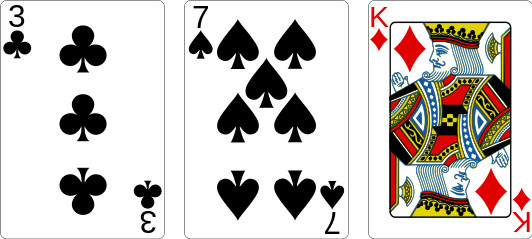
acronical
adj. occurring at or just after sunset

acronical
adj. occurring at or just after sunset

In 1967, Jim Thompson left his silk business in Thailand for a Malaysian holiday with three friends. On the last day, he disappeared from the cottage in which they were staying. In this week’s episode of the Futility Closet podcast we’ll review the many theories behind Thompson’s disappearance, which has never been explained.
We’ll also borrow John Barrymore’s corpse and puzzle over a teddy bear’s significance.

Back in 2009 I worried that, if vampires are constantly converting humans, eventually we must all succumb.
Apparently this fear is not unfounded. In 2006 physicists Costas Efthimiou and Sohang Gandhi worked out that if the first vampires had turned up in 1600, if they’d needed to feed only once a month, and if the world population at that time had been 536,870,911 (as estimated), then the vampire population would have increased geometrically and the last human would have succumbed in June 1602, after a bloodbath of only two and half years.
Worse, in 1982 a team of Austrian mathematicians led by R. Haiti and A. Mehlmann found that intelligent vampires could calculate a bloodsucking frequency that would maximize total utility per vampire and keep the human race alive indefinitely — and solutions exist no matter whether they’re “asymptotically satiated vampires,” “blood-maximizing vampires,” or “unsatiable vampires.”
Later they expanded on this to show that cyclical bloodsucking patterns are optimal. That’s not very comforting.
(Dino Sejdinovic, “Mathematics of the Human-Vampire Conflict,” Math Horizons 16:2 [November 2008], 14-15.)

Shuffle a deck and deal three cards face down. A friend looks at the cards and turns up two that are the same color. What’s the probability that the remaining card is also of this color?
The answer is not 1/2 but 1/4. Three randomly selected cards might have any of eight equally possible arrangements of color. In only two of these (RRR and BBB) are all the colors the same. So the chance of this happening is 2/8 = 1/4.
(Martin Gardner, “Modeling Mathematics With Playing Cards,” College Mathematics Journal 31:3 [May 2000], 173-177.)
10/18/2020 UPDATE: A number of readers have pointed out that the probabilities here aren’t quite accurate. Gardner was trying to show how various mathematical problems can be illustrated using a deck of cards and contrived this example within that constraint, focusing on the “seeming paradox” of 1/4 versus 1/2. But because the cards are dealt from a finite deck without replacement, if the first card is red then the second card is more likely to be black, and so on. So the final answer here is actually slightly less than 1/4 — which, if anything, is even more surprising, I suppose! Thanks to everyone who wrote in about this.

When the Greek engineer Eupalinos contrived a tunnel in the 6th century B.C. to carry water through Mount Kastro to Samos, he started digging simultaneously from the north and south, hoping that the two tunnels would meet in the heart of the mountain. He arranged this through some timely doglegs: When the two teams could hear one another (meaning they were about 12 meters apart), each deviated from its course in both the horizontal (left) and vertical (right) planes:

This ensured that they wouldn’t tunnel on hopelessly past one another on parallel courses.
This worked amazingly well: In fact the vertical alignment, established using levels at the start, had been maintained so faithfully that the two tunnels differed by only a few millimeters, though they’d traversed a combined distance of more than a thousand meters.
This is only the second known tunnel to be excavated successfully simultaneously from both ends, and the first to accomplish this feat using geometric principles, which Euclid would codify only centuries later.
Inspired by his wife’s art studies, physicist David C. Roy turned his training to sculpture and began fashioning moving mechanisms of birch, not clocks themselves but clocklike in that they’re wound by hand and then run unpowered, sustaining their motion through escapements, suspended weights, and constant force springs.
“I saw it as another type of creative problem solving, not all that different from my advanced physics courses, but with a completely different goal,” he writes. “To this day, I find art and science to be closely linked.”
More on his website and YouTube channel.
Two Sheffield engineers introduced this brainstorm in 1939 — when a motorist realizes he’s about to hit a pedestrian he can pull an emergency lever and the bumper deploys a life-saving “scoop.”
A similar device had appeared in Berlin in 1927 (below). I don’t know whether either was put to practical use.
French painter Joseph Ducreux (1735–1802) was fascinated with physiognomy, the notion that a person’s character is reflected in their outward appearance — and this led to some decidedly unconventional self-portraits.
At the same time, Franz Xaver Messerschmidt (1736-1783) was doing similar work in three dimensions.

“Gotham City is Manhattan below 14th Street at eleven minutes past midnight on the coldest night in November, and Metropolis is Manhattan between 14th and 100th Streets on the brightest, sunniest July day of the year.” — Dennis O’Neil
“Metropolis is New York in the daytime; Gotham City is New York at night.” — Frank Miller
“Change the Color,” by Haruaki Fukuda of the University of Tokyo, won second prize in the Neural Correlate Society’s 2019 Best Illusion of the Year Contest:
Among the honorable mentions is “3D Graffiti,” by Jack Bowers:
Bowers’ figure reminds me of Patrick Hughes’ disorienting “reverspectives.”